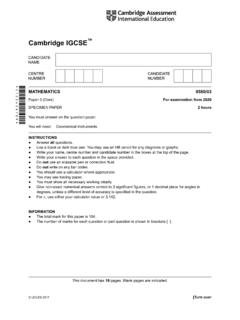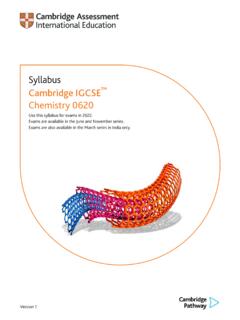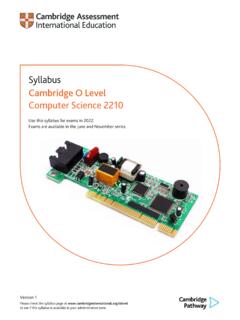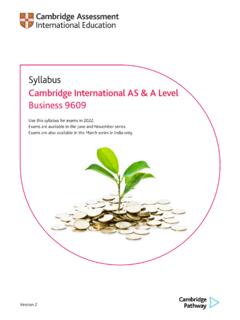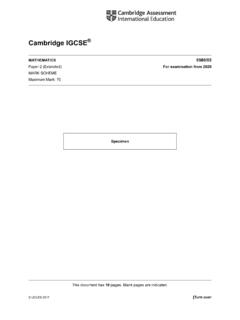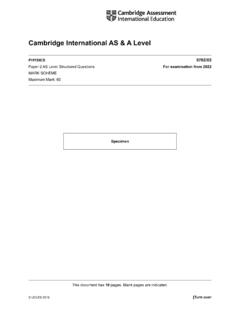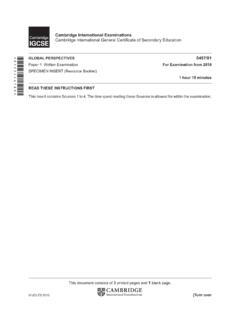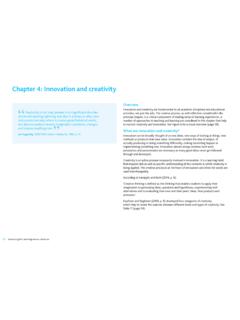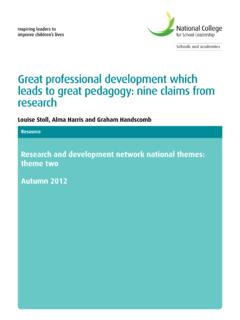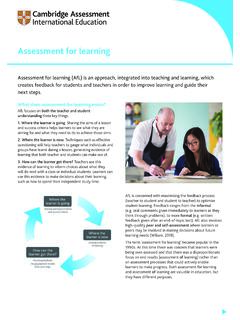Transcription of Metacognition
1 What does Metacognition mean?The prefix meta means about the thing itself. So, Metacognition is cognition about cognition , or thinking about one s thinking . It is often considered to have two dimensions: metacognitive knowledge and metacognitive regulation. Metacognitive knowledge includes the learner s knowledge of their own cognitive abilities ( I have trouble remembering dates), the learner s knowledge of the nature of particular tasks ( the ideas in this article are complex), and the learner s knowledge of different strategies including when to use these strategies ( if I break telephone numbers into chunks I will remember them) (Brown, 1987; Flavell, 1979). Metacognitive regulation describes how learners monitor and control their cognitive processes.
2 For example, realising that the strategy they are using to solve a mathematical problem is not working and trying another approach (Nelson & Narens, 1990). Monitoring and control are described in more detail in the following describes the processes involved when learners plan, monitor, evaluate and make changes to their own learning is the theory behind Metacognition ?A theory of metacognitive regulation that is widely cited in the research literature is Nelson and Narens (1990) model of Metacognition . This consists of two levels: the object level and the meta level (see Figure 1 below). The object level is where cognitive processes or one s thinking occurs. One example is decoding text when reading. At the object level, cognitive strategies ( decoding) are used to help the learner achieve a particular goal (understanding the meaning of the text).
3 This is cognition. The meta level is where thinking about thinking takes place. At this higher-order level, metacognitive strategies are used to make sure the learner reaches the goal they have set. To continue with the reading example, this would begin with the learner thinking about how well they have understood the paragraph they have just read. This is termed monitoring. If they are happy with their comprehension level they will continue reading. If not, they will perhaps re-read the paragraph, or decide to use a dictionary to help their understanding. These actions are called control processes, as they are changing the learner s cognitive processes or related behaviours, based on the monitoring feedback. This is 1.
4 Nelson and Narens (1990) Model of MetacognitionOBJECT LEVEL(cognition) , checking that you understand what you are readingMETA LEVEL( Metacognition ) , re-reading a paragraph, or reading slower to ensure better comprehensionPerkins (1992) defined four levels of metacognitive learners: tacit; aware; strategic; reflective. Tacit learners are unaware of their metacognitive knowledge. They do not think about any particular strategies for learning and merely accept if they know something or not. Aware learners know about some of the kinds of thinking that they do generating ideas, finding evidence, etc. but thinking is not deliberate or planned. Strategic learners organise their thinking by using problem solving, grouping and classifying, evidence seeking, decision making, etc.
5 They know and apply the strategies that help them learn. Reflective learners are not only strategic about their thinking but they also reflect upon their learning while it is happening, monitoring the success of any strategies they are using and then changing them as appropriate. What other terms are associated with Metacognition ? Self-regulated learning is a broader term, encompassing cognition, metacognitive knowledge, metacognitive regulation and the motivation necessary to employ these strategies successfully (EEF, 2019). Metamemory the metacognitive aspects of learning and memory (Nelson & Narens, 1990).What are the benefits of Metacognition ? Metacognitive practices help learners to plan, monitor and evaluate their own progress and take control of their learning as they read, write and solve problems in the classroom.
6 Research indicates that Metacognition is a powerful predictor of learning. Metacognitive practices make a unique contribution to learning over and above the influence of cognitive ability. The implication of this research is that improving a learner s metacognitive practices may compensate for any cognitive limitations they may have (Veenman, Wilhelm & Beishuizen, 2004; Wang, Haertel & Walberg, 1990). Metacognitive practices have been shown to improve academic achievement across a range of ages, cognitive abilities and learning domains. This includes reading and text comprehension, writing, mathematics, reasoning and problem solving, and memory (Dignath & Buttner, 2008; EEF, 2019; Hattie, 2009). Metacognitive skills can help students to transfer what they have learnt from one context to the next, or from a previous task to a new task.
7 The teacher can support this by explaining how what has been learnt from one task can be applied to the continuedWhat are the misconceptions of Metacognition ? Metacognition is always deliberate. Many Metacognition researchers highlight the conscious, deliberate nature of Metacognition . An alternative approach is to say that less conscious, automatic processes are also metacognitive. For example, a learner may check work for errors as they write, out of habit, with little awareness that they are doing so until an error is identified. The notion of automatic or implicit Metacognition may cause further difficulties in distinguishing cognitive from metacognitive processes. However, it has led to more sophisticated models of Metacognition , particularly in the area of Metacognition in young children (Whitebread et al.)
8 , 2009). Metacognition is for older students. In contrast to the view that metacognitive skills emerge at the age of 8 to 10 years old, Veenman & Spaans (2005), Whitebread & Pino-Pasternak (2010) and Larkin (2010) document a number of studies which indicate evidence of young children s metacognitive abilities. Findings include children as young as 18 months demonstrating error-correction strategies, 5 to 6-year-old children showing understanding of memory processes, and 3 to 5-year-olds exhibiting a wide range of verbal and non-verbal indicators of metacognitive processes in nursery and reception classrooms. These studies demonstrate that although young children may not be able to describe the metacognitive processes they are exhibiting, it does not mean that these processes are not occurring.
9 Practical tips: How can schools make the best use of Metacognition ? Prioritise professional development in Metacognition . There should be an explicit focus on teaching both cognitive and metacognitive techniques, and how to create a learning environment that supports the development of metacognitive skills and motivation. Encourage teachers to work together and share practice that promotes the development of metacognitive abilities in the classroom. For example, a group could meet regularly to reflect on a reading about Metacognition or to share their experiences of implementing a new strategy. Support teachers in encouraging metacognitive practices at school. For example, exam wrappers are worksheets that learners complete before and/or after they receive test feedback.
10 These include questions to help learners to reflect on the processes of planning, monitoring and evaluation when preparing for and sitting the test. Embed metacognitive strategies in high-quality subject teaching rather than as decontextualised generic skills training (EEF, 2019). Involve the whole school community in promoting metacognitive talk. Monitoring and evaluating performance and using learning strategies effectively is not only helpful in the classroom, but also in the wider school and beyond. Evaluate the impact of new strategies that are implemented, whether these are tried across the whole school or by individual teachers or departments (see Getting Started with Evaluating Impact). How can teachers make the best use of Metacognition ?

